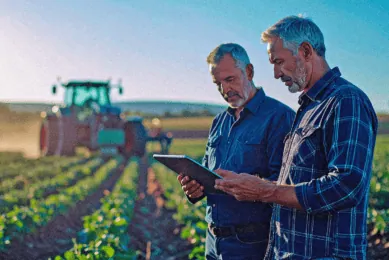Making AI affordable

University of Illinois institute is developing smaller scale, lower-cost autonomous farm technology.
Initiatives to develop farm-focused artificial intelligence (AI) technologies are ongoing worldwide, including through institutions in the United Kingdom, The Netherlands, and elsewhere. The approach each institution takes, though, is not necessarily uniform.
For some American researchers, affordability and smaller-scale practicality are the nucleus of AI innovation.
AIFARMS
In September 2020, Future Farming reported the Center for Digital Agriculture at the University of Illinois launched the Artificial Intelligence for Future Agricultural Resilience, Management, and Sustainability (AIFARMS) Institute. A joint effort between the National Science Foundation and United States Department of Agriculture, the research body aims to improve AI technology and find innovative ways to use it to tackle an array of farming challenges.
The end goal is to develop a prototype autonomous farm where low-cost AI-driven systems enable breeders and farmers to achieve significant improvements in profitability and environmental impact.
Text continues underneath image
Using AI to promote more effective autonomous farming
The institute is taking a two-pronged approach to achieve its goals. One element is to find the best ways of using AI to promote more effective autonomous farming and livestock management, better environmental resilience, as well as soil health management and improvement.
Examples in these categories include focusing on welfare-promoting herd management or labour-reducing technologies, soil health and nutrient flow monitoring, and much more besides.
Solving “foundational AI goals”
The other part of the AIFARMS approach involves solving “foundational AI goals.” According to Vikram Adve, the institute’s director and professor in the University of Illinois Computer Science Department, the term refers to AI development problems common to all applications of the technology, regardless of sector or purpose.
Text continues underneath image
Speech or facial recognition
Speech or facial recognition offers an example of this problem – and one AIFARMS is specifically exploring. It could be used to help livestock farmers identify and monitor individual animals within large herds, but gathering enough data to recognise human faces, let alone the more difficult animal visage, is very difficult.
Indeed, no matter where it’s employed, facial recognition requires a colossal amount of data for the learning program to process.
We are exploring how can we make machine learning more accurate with limited data
“The larger the data sets are the better, but a major issue is getting those data sets is very expensive,” says Adve. “We are exploring how can we make machine learning more accurate with limited data.”
How humans interact with AI systems
Another foundational barrier relates to how humans interact with AI systems. Because most systems still require a human to some degree, Adve says good two-way communication is a necessity. But AI algorithms are not always easily interpretable, and they struggle to understand regular human communication.
“How do you make algorithms interpretable for humans, where we can see the process not just as a black box of data with an answer at the end? Also, there’s communication through natural language. It would be far better if it could operate with casual speech or text.”
A robot in the field should, for example, be able to both see, and communicate that it saw, leaf blight plainly – rather than through a complex interface.
Overall, finding solutions to these and other foundational AI problems means pursuing more financially feasible and user-friendly approaches. It’s not specific to agriculture, but Adve reiterates analysing the problems via an agricultural lens is complimentary to their search for practical on-farm applications.
Text continues underneath image
Smaller scale equals smaller costs
As more efficient data management and better communication drives down the cost of AI technologies, it can increasingly be applied to smaller machines – itself a significant money-saver given the high costs of large equipment, whether autonomous or conventional.
Adve says such advances would be a boon to smaller farmers and ranchers, or those otherwise caught in circumstances where the scale of equipment, labour, and other factors are in some way mismatched to the size of their business.
You could buy hundreds of small robots for one large harvester, and use them to do a wide variety of jobs like seed breeding or weeding
“We are not trying to make large equipment autonomous or use that. Our approach is trying to start with small robots that are two feet cube,” says Adve. “You could buy hundreds of them for one large harvester, and use them to do a wide variety of jobs like seed breeding or weeding.”
Indeed, small robots have already been acquired and used by AIFARMS researchers for a variety of tasks, including cover crop seeding, weeding, and agronomic work. The ever-present goal is to successfully expand this pool of workable jobs.
Text continues underneath image
Mechanical weeding
Harvesting, however, is one area small robots hit a practicality barrier. That said, they can in some cases operate between rows and under the crop canopy. This opens a range of potential jobs, though Adve specifically highlights mechanical weeding as a very valuable task as herbicide resistance issues proliferate in severity and frequency.
This small-scale focus is what sets AIFARMS apart from other farm-focused AI initiatives, such as the aforementioned projects ongoing in the United Kingdom and The Netherlands. While Adve believes both are doing good work, utilising large equipment can make addressing technology costs more difficult.
“The robots we are using are in the range of $ 7,000 to $ 10,000 each and we’re hoping to bring the price down,” he says. “Bringing down the cost can increase the number of robots farmers can use.”
Join 17,000+ subscribers
Subscribe to our newsletter to stay updated about all the need-to-know content in the agricultural sector, two times a week.



